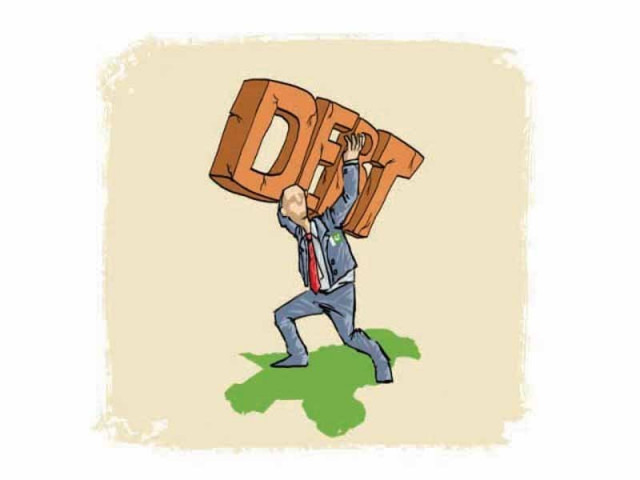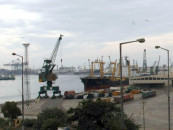Finding solution: Effective debt management strategy can ease mounting burden
Country’s public debt surges by Rs1.7 trillion in just one year.

The public debt increased by Rs1.7 trillion in just one year, aggregating to Rs16.321 trillion, of which the external debt was Rs6.151 trillion. ILLUSTRATION: JAMAL KHURSHID
The public debt increased by Rs1.7 trillion in just one year, aggregating to Rs16.321 trillion, of which the external debt was Rs6.151 trillion. The public debt was 64.3% of GDP, an indicator of the country’s indebtedness and bursting the 60% ceiling set under the Fiscal Responsibility and Debt Limitation Act 2005.
Also, the government was unable to meet the quarterly limit of zero (net) budgetary borrowing from the SBP, as prescribed in the SBP Act 1956, for three quarters of the year.
The public debt, a burden on the exchequer, stood at 4.5 times of government revenue in FY14 and the interest payment was one-fifth of total government expenditure.
Budget deficit
In the year, the country had a budget deficit of Rs1.388 trillion, which was 5.5% of GDP and the gap was bridged mainly through domestic as well as external borrowing.

Domestically, Rs1.200 trillion was borrowed from various sources including borrowing from commercial banks and non-banking institutions amounting to Rs717.2 billion. Similarly, the external financing stood at Rs511.7 billion.
Apart from this, a shortfall in most of the other areas needed borrowing due to insufficient flow of funds from their own resources, for instance, the trade deficit widened in FY14 to reach a record high of $16.5 billion.
However, in terms of GDP, the external gap was much lower than the imbalances seen in FY08 and FY09.
Domestic borrowing
For the last many years, Pakistan’s economy had continuously grown in such a way that it landed into a severe debt trap and there seems to be no hope to come out of it unless the government frames and implements with full sincerity a debt management strategy for the country to gradually get rid of this menace.
The SBP report has mentioned that while looking again at the composition of the public debt, the single most important development was the significant substitution of short-term debt (T-bills) with medium to long-term debt (PIBs). With an unprecedented increase of Rs1.9 trillion in FY14, the share of permanent debt has jumped to 37.1% from 22.8% a year before.
Interestingly, banks offered Rs1.9 trillion in PIB auctions against the pre-auction target of Rs480 billion and the government accepted almost the entire amount. This would cost heavily as interest rates have perhaps already peaked. Interest payment on domestic debt stood above Rs1 trillion in FY14.
The government had drained out funds from all possible sources, even commercial banks with the lure of high interest rates in T-bills and PIBs jumped in to earn hefty profits while their principal amount would remain secured. In fact, the banks ignored their professional and national obligation to finance the business and industry.
This is why lending to businesses slowed down sharply and virtually the banks became money lenders where no professional skill was required.
Pakistan’s external debt and liabilities showed a $4.6 billion increase, reaching $65.5 billion by the end of FY14. This rise was driven by the $2 billion raised through Eurobonds; and the disbursements from international financial institutions including $1.675 billion from the IMF during the year under review.
However, on account of large loan repayments, net flows from the fund stood at a negative $1.5 billion in the year. In addition to this, revaluation losses from the depreciation of the US dollar against major currencies also increased the country’s public debt by $483.7 million during the year.
Debt sustainability
Although the revival of external loan disbursements in FY14 is encouraging, yet their implication for the sustainability of external debt raises concerns.
Some financial experts have analysed the liquidity indicators of external debt sustainability, which means the long-term ability of a country to make debt repayments, and their analysis shows that almost all indicators have recorded some erosion in the year.
The report further says the external debt servicing-to-foreign exchange earnings ratio weakened primarily because of bulky repayments to the IMF.
The government must seriously think that they have to steer the country out of the debt trap but not with its old empty slogan of 1998 “Karz Utaro, Mulk Sanwaro”.
The writer is a director in one of the four largest banks in Pakistan and also a consultant to the ADB
Published in The Express Tribune, February 2nd, 2015.
Like Business on Facebook, follow @TribuneBiz on Twitter to stay informed and join in the conversation.


















COMMENTS
Comments are moderated and generally will be posted if they are on-topic and not abusive.
For more information, please see our Comments FAQ